
Trametes versicolor – also known as Coriolus versicolor and Polyporus versicolor – is a common polypore mushroom found throughout the world. Meaning 'of several colors', versicolor reliably describes this fungus that displays a variety of colors. For example, because its shape and multiple colors are similar to those of a wild turkey, T. versicolor is commonly called turkey tail. A similar looking mushroom, commonly called false turkey tail, which is from a different order, may sometimes be confused with the turkey tail mushroom due to appearance. Another lookalike is the multicolor gill polypore.

The Sciaridae are a family of flies, commonly known as dark-winged fungus gnats. Commonly found in moist environments, they are known to be a pest of mushroom farms and are commonly found in household plant pots. This is one of the least studied of the large Diptera families, probably due to the small size of these insects and the similarity among species.

Sciaroidea is a superfamily in the infraorder Bibionomorpha. There are about 16 families and more than 15,000 described species in Sciaroidea. Most of its constituent families are various gnats.

Bolitophila cinerea is a Palearctic species of 'fungus gnat' in the family Bolitophilidae.
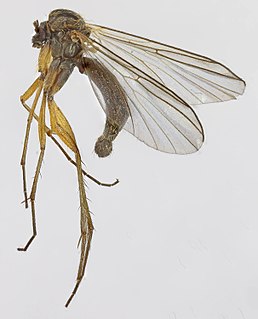
Boletina trispinosa is a Palearctic species of 'fungus gnat' in the family Mycetophilidae. Members of this genus are found in a wider variety of habitats from wooded streams to wetlands and open moorland. They make use of diverse breeding sites from the more normal habitat of rotting wood to mosses and liverworts. The breeding biology of most species is largely unknown.
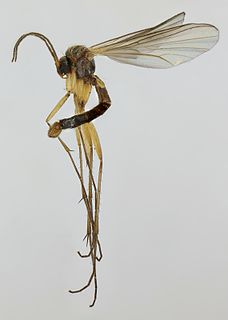
Coelosia tenella is a Palearctic species of 'fungus gnat' in the family Mycetophilidae. It is associated with Stereum.

Cordyla flaviceps is a Palearctic species of 'fungus gnat' in the family Mycetophilidae.The type-locality is Copenhagen (Denmark). C. flavicepsis a mycetophage associated with Russula and Lactarius.

Diadocidia ferruginosa is a Palearctic species of fungus gnat in the family Mycetophilidae. They live as larvae in long dry silken tubes under bark or in rotten wood and probably feed on fungal mycelia or spores. Also associated with Peniophora.
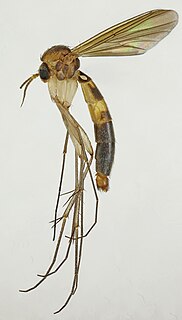
Exechia contaminata is a Palearctic species of fungus gnat in the family Mycetophilidae. Exechia contaminata is chiefly or exclusively associated with Russula and Lactarius.
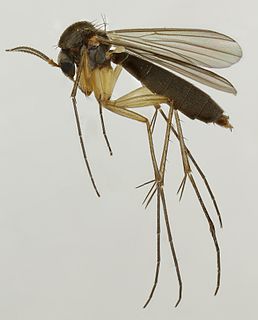
Exechia spinuligera is a Palearctic species of fungus gnat in the family Mycetophilidae. Exechia contaminata is chiefly or exclusively associated with Russula and Lactarius.
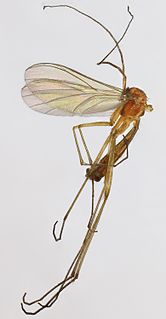
Macrocera parva is a Palearctic species of 'fungus gnat' in the family Keroplatidae.Larvae of species in this genus have been reared from a range of situations including clumps of turf, rotting wood and cave walls and are thought to be predaceous.

Mycetophila edwardsi is a Palearctic species of 'fungus gnat' in the family Mycetophilidae. Mycetophila edwardsi is found in forest or wooded areas where the larvae develop in fruiting bodies of large fungi.

Mycetophila formosa is a Palearctic species of 'fungus gnat' in the family Mycetophilidae. Mycetophila formosa is found in forest or wooded areas where the larvae develop in Phlebia radiata and moist, strongly decayed wood of birch and spruce log bearing Trechispora hymenocystis.

Mycetophila fungorum is a Palearctic species of 'fungus gnats' in the family Mycetophilidae. Mycetophila fungorum is found in forest or wooded areas where the larvae develop in Agaricales and also obtained with emergence traps over dead wood, soil and ground flora.
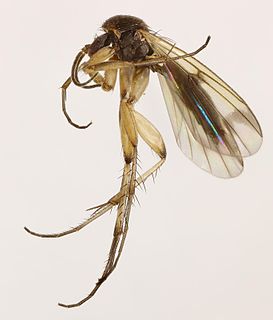
Mycetophila luctuosa is a Palearctic species of 'fungus gnats' in the family Mycetophilidae. Mycetophila luctuosa is found in forest or wooded areas where the larvae develop in Neolentinus lepideus, Kretzschmaria deusta, Chondrostereum purpureum, Sebacina incrustans, Neolentinus tigrinus, Pleurotus spp., Trametes versicolor and a wide range of epigeic fungi, mostly Russulaceae.
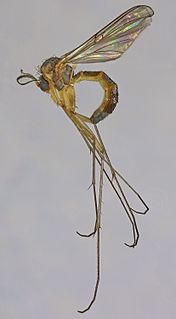
Mycomya cinerascens is a Palearctic species of 'fungus gnats' in the family Mycetophilidae. Mycomya cinerascens is found in forest or wooded areas where the larvae develop in fruiting bodies of Stereum, Thelephora terrestris and Cortinarius sp..Besides fruiting bodies the species has been collected with emergence traps over beech logs and stumps, alder and spruce stumps.

Boletina gripha is a Palearctic species of 'fungus gnats' in the family Mycetophilidae. It is found in a wide variety of habitats from wooded streams to wetlands and open moorland. Reared from brown rot of spruce stump, spruce log bearing loose bark and decaying wood of pine. Larvae have been on the surface of decaying wood covered with Resinicium bicolor, from soil in pine forest and from fruiting bodies of Suillus bovinus.

Brachypeza bisignata is a Palearctic species of 'fungus gnat' in the family Mycetophilidae. Reared from puffballs (Lycoperdales).

Boletina trivittata is a Palearctic species of 'fungus gnat' in the family Mycetophilidae. Members of this genus are found in a wider variety of habitats from wooded streams to wetlands and open moorland. Adults have been obtained in emergence traps in a range of situations including rotting wood and soil litter.
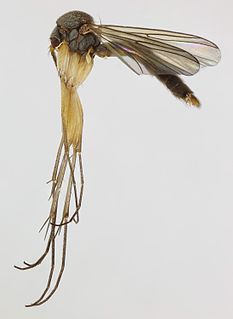
Brevicornu foliatum is a Palearctic species of 'fungus gnat' in the family Mycetophilidae. Members of this genus are found in a wider variety of habitats from wooded streams to wetlands and open moorland. Larvae develop in dead wood and in soil litter, feeding probably on microfungi.





















